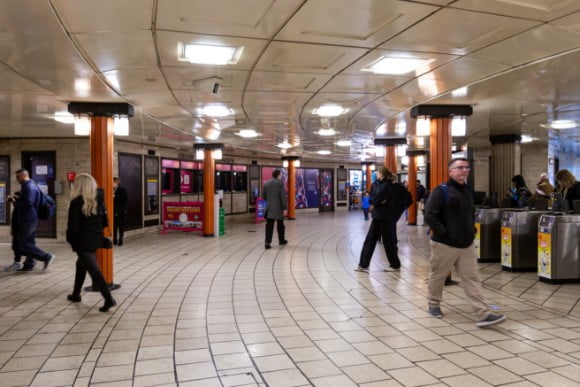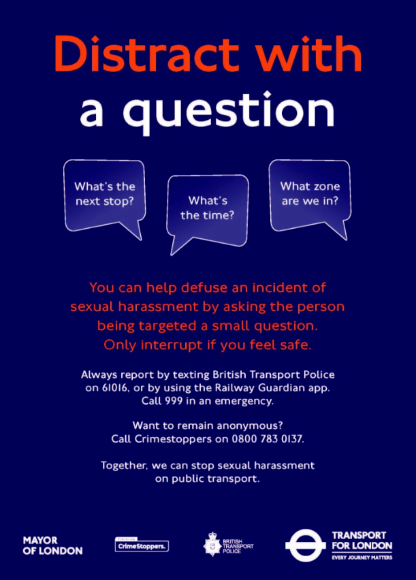As hate crimes – especially involving anti-Semitic or Islamophobic sentiments – continue to rise nationwide, more than six out of ten people in London would feel more confident getting involved in diffusing a situation if they had more information on how they could help.
The findings come from figures provided by London TravelWatch which showed that six out of ten people using public transport in the capital are loath to get involved as an ‘active bystander’.
Those who are brave enough to stand up to anti-social behaviour, which includes not only hate crimes but also other incidents, including sexual harassment, can help de-escalate the incident or even prevent it from happening in the first place.
As part of a move to mark International Bystander Awareness Day, Transport for London (TfL) has been helping customers understand how they can become involved in helping crime prevention measures across the network.
The annual National Bystander Awareness Day began in 2019, run by charity Communities Inc, to unite people against hate and hostility.
In January 2023, the event expanded internationally.
Early intervention in criminal activities, harassment or anti-social behaviour can often diffuse the situation and make the whole environment safer for fellow travellers.
TfL has been instrumental in encouraging customers to take a stand, but only if the passenger feels safe to do so.
Distracting the perpetrator is top of the list and people are being encouraged to ask the potential victim a simple but unrelated question.
Suggestions include ‘do you know the time?’ or ‘do you know the next stop?’

The bystander should make a note of what has happened, including any information about the offender, and details should be forwarded to British Transport Police (BTP) on 61016.
Alternatively, rail passengers can use the Railway Guardian app. If the situation develops into an emergency, the bystander should always call 999 without delay.
Finally, the victim should always be asked if they are alright and whether they need additional help.
Late last year, TfL funded eight sessions organised by charity Protection Approaches to empower people to take action to prevent or reduce harm when they encounter hate crime, asking them to respond to a series of hypothetical scenarios. A series of follow-up sessions will take place later this spring to gain an understanding of how the initiative has improved people’s confidence to respond to hate crime.
Security issues will continue to be tackled. By 2026, a better understanding of the concerns regarding safety and security among disabled customers, women and girls, as well as LGBTQ+ people will be in place. The following year, frontline staff will be provided with training, guidance and tools to support victims of sexual violence and harassment, and hate crimes.

“The Mayor and I want everyone to be able to use public transport without fear of abuse and TfL takes a zero-tolerance approach to hate crime. Today, I’m asking Londoners to join us in sending the message that hate has no place in our city.
“Londoners have told us that they want to be able to intervene safely if they witness a hate crime, and they would feel more confident doing so if they had information on the best and safest ways to help. That is why TfL is engaging with Londoners on how to be an active bystander against hate crime and violence against women and girls to build a better, safer London for everyone.”
London’s Deputy Mayor for Transport, Seb Dance
“Everyone should be and feel safe when using public transport and making this a reality is our top priority. On International Bystander Awareness Day we are supporting Londoners who want to be active bystanders, to help de-escalate incidents and support each other.”
Siwan Hayward, TfL’s Director of Security, Policing and Enforcement






Responses
Here’s a radical suggestion. How about providing more police on foot patrol to help deter the criminals in the first place? To be blunt, what are we paying our taxes for?
“Those who are brave enough to stand up to anti-social behaviour, which includes not only hate crimes but also other incidents, including sexual harassment, can help de-escalate the incident or even prevent it from happening in the first place . . . ”
. . . or they could get their heads kicked in. And, knowing what the Metropolitan Police are like, these days, if the aggressor claims to have suffered the slightest injury, the ‘brave’ person is likely to find THEMSELVES charged with anything from a public order offence up to ABH – even if the claim proves entirely spurious. And, yes – that IS the voice of experience!
Further to previous.If you don’t know what sort of things I efer to, just examine, online,the worry created in Scotland followed the instigation of the Hate Crime and Public Oder Act (Scotland),2021.In a nutshell ,grave fears of people being wrongfully accused of what ever is interpreted as “hate. crime ” ( however wrongly , vexatiously or maliciously the allegations might be made), the probability of gross waste of police time and grave implications for freedom of speech.
Yes common sense judgements have always been valid but there are those with “agendas” who might like to exploit such messages.
This initiative is fraught with difficulty.1. you could get seriously assaulted if you misjudge the situation.It is also asking members of the public to make a subject judgement as to what is a hate crime, bearing in mind that judgements of this sort are very much a topic of disagreement by politicians, human rights lawyers, human rights groups, “The Free Speech Union and loads of other organisations.
This is akin to posters on the underground and other urban rail systems, which ask people to report people who “stare” at other people on trains.Howcan anyone possibly interpret stares?
The police and British Transport Police have appalling conviction rates and wholesale investigations into things which are not strictly criminal, if nothing else, divers them from more important investigations.
Surely, the best approach generally , is to ask people to stick to the “see it, say it, sorted ” phone call and let the police make the call about what to do.